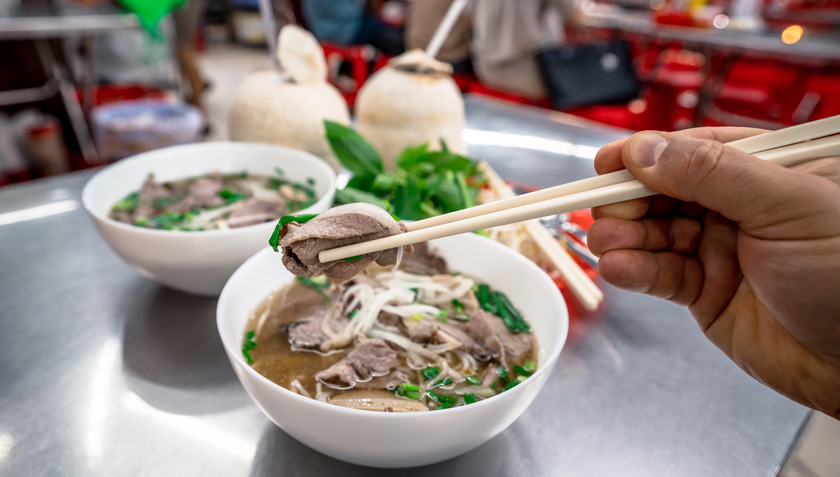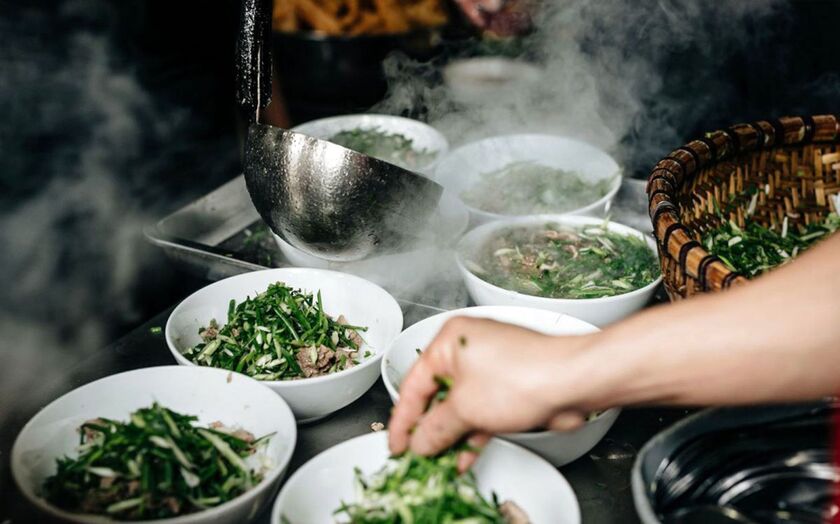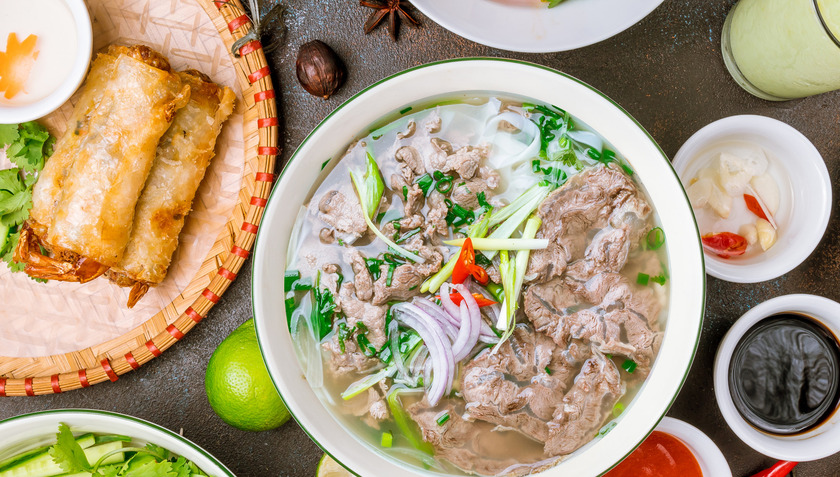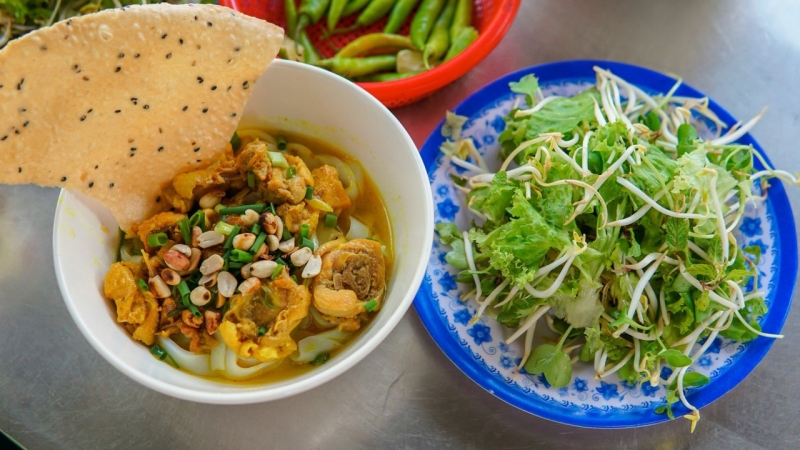This is an important milestone in the journey of preserving and promoting the cultural identity of Vietnamese cuisine when Hanoi pho and Nam Dinh pho were officially recognized by UNESCO as intangible cultural heritage. Not only a dish, pho is also a part of the soul of the Vietnamese people, the crystallization of culinary quintessence and national spirit.
With a deep love for Hanoi cuisine, Vu Bang used his pen to capture memorable moments of a bowl of pho, evoking in the reader many indescribable emotions. He depicted a part of the "ancient history" of Hanoi pho, an image that cannot be erased in the minds of those who love this dish.

For every Hanoian, pho is always a familiar dish, a unique feature in the culinary culture of the Northern Capital region.
During the difficult subsidy period, pho was considered the most luxurious gift, only when someone in the family was sick could they buy pho. Until now, most people believe that pho originated in Nam Dinh in the early years of the 20th century, then spread to all provinces and cities and to this day, pho has been present in many countries around the world as a specialty branded with Vietnam.
In his work, Vu Bang once compared the cuisine of the thousand-year-old capital to immortal literary works, which if the writer "Even if I were taken to a foreign land for a thousand years, I would still be Vietnamese because I would never forget the delicious dishes of Hanoi.".
He seemed to immerse himself in the sky and earth, in his homeland, so that each south wind, each hot sunny day, or when autumn clouds covered the sky, reminded him of a special seasonal delicacy. Perhaps because he lived in the South, his nostalgia for Hanoi and the North was deeply engraved in every page he wrote. He wrote about the products of each season, about each kind of cake, each dish he enjoyed during “the sweet days with his old mother and foolish wife under the old mossy roof”, such meals, although frugal, were enough to make the writer “more delicious than eating fish or bird’s nest”.

In Hanoi of the old days, it was not difficult to come across pho vendors with familiar cries echoing from dawn until late at night.
Vu Bang has likened pho to the "national soul" of Vietnamese cuisine. He affirmed in his book "Hanoi's Delicacies" an immutable truth: Vietnamese people may not eat all kinds of dumplings and rice cakes, but certainly no one can ignore the delicious taste of a bowl of pho.
"Very cheap. According to the value of silver coins now, a bowl of pho is five dong, and three dong is still a good bowl of pho. Therefore, from a salesgirl in a shop to a civil servant, from a noblewoman whose house has a red and gold-plated door, to a worker who can barely make ends meet, everyone eats a bowl of pho. If it tastes good, they eat two, but I personally have seen people have three bowls for breakfast, each bowl costing eight dong, which adds up to twenty-four or twenty-five dong.
Through the glass door, what did we see? A bunch of green onions like young leaves, a few red peppers tied to a string, a few pieces of fresh and tender beef, some well-done, some rare, some cartilage, some lard, some ribs... The vendor stood there slicing cakes and meat, occasionally opening the lid of an iron bucket to pour broth into bowls. A wisp of smoke spread throughout the stall, covering the people sitting around eating in a thin mist, vague like a Chinese painting of immortals playing chess in an autumn forest.
Vu Bang is like a true food critic, he remembers every pho restaurant, every type of meat, every unique flavor. Old Hanoi appears through Vu Bang's writings with all the flavors of pho. He remembers every pho restaurant, every pho name. In the 50s of the last century, in Hanoi, there was a famous pho guy named Sut who created pho gio (beef rolled up like a ham, like gio, boiled, then sliced into thin slices and topped with rare meat), now called nam.

Pho is considered the "national soul" of Vietnamese cuisine.
The pho at Phu Doan hospital was edible but the broth was a bit bland; the pho at Dong My on the new street was soft but the ginger was a bit too much; the pho at Cong Vong was delicious but the broth was a bit smelly; the pho at Mu Do behind the temple at Hom market... Then the pho at Tau Bay, where people stood all over the intersection at the beginning of Ham Long street every morning, then the pho at Tu, the pho at Trang (in front of Hang Than school) was known as the "king of pho 1952". He was not only a gourmet but also a talented writer, who used his pen to praise and preserve beautiful memories of this national dish.
He called that bowl of pho a “pho poem”: “Just looking at a bowl of pho is interesting. A handful of pho noodles, some thinly sliced green onions, a few fragrant green herbs; a few thin slices of yellow ginger, sliced as smooth as silk; a few thin slices of chili, either red like hibiscus or dark red like pomegranate flowers... the meat is soft, the noodles are chewy, sometimes you can feel the spiciness of ginger, the spiciness of pepper, the spiciness of chili; sometimes you can feel the light fragrance of green onions, the pungent fragrance of herbs, the gentle fragrance of fresh and tender beef...”.To know the true value of a pho restaurant, you must eat a bowl of pho cooked only, if it is delicious then it is truly delicious. And the most important thing of all pho restaurants lies in the secret of the broth.
Under the talented pen of Vu Bang, Hanoi cuisine appears not only as dishes, but also as a vivid picture of the culture and people here. The image of long lines of people waiting for a hot bowl of pho in the early morning, or willing to climb up to shabby, dirty, dark attics to enjoy the fragrant pho has become an indispensable characteristic. It is not simply a need to eat and drink, but also a unique cultural experience.

Certainly, Vietnamese pho in general and Hanoi pho in particular will forever exist over the years, continuing to witness the changes and ups and downs of society.
One of the ingredients used to make pho that people today know the least is probably the sea worm. The sea worm is a seafood known as the “pure gold” of the Quang Ninh sea, the ultimate flavoring of pho. It is said that, to make the pho broth sweet and naturally delicious, in addition to using marrow bones, bone marrow and other cardamom, a handful of small, dried sea worms must also be added. It is the sea worm that creates the sweet, unmistakable flavor of old Hanoi pho.
Through his writings, we seem to be immersed in the bustling atmosphere of Hanoi streets. We hear the street vendors' cries echoing through every corner, smell the delicious aroma of food filling the streets. And above all, we feel the deep love he has for his homeland.
That precious food has reached the pinnacle of culinary perfection, wanting to innovate or change is impossible. Even a small change will cause the flavor of the dish to be hybridized and transformed. So the descendants still only eat pho like that, accustomed to the old way of enjoying it of their ancestors, but certainly the difficulty is very difficult to compare. Northern people are gourmets and picky eaters, they easily get angry if the food does not suit their taste. Therefore, revolving around food alone there are enough funny and sad stories.
Gourmets, people who know how to eat well, eating a delicious piece of the country feels a happiness flare up in their hearts, because they have eaten a bit of the country, a quintessence passed down from year to year.




































